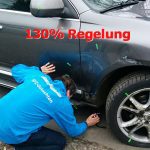If there is damage to the vehicle that should no longer be repaired from an economic point of view, the car can still be saved with the 130% rule.
If there is an accident, the expert often comes to the conclusion that the vehicle involved in the accident is a total loss. The injured party usually makes a negative deal with such a statement. The legislator has used this situation to allow an exception in the claims settlement. This exception is described in the 130% rule. It enables the vehicle to be repaired, even if it is a total loss.
The special regulation in claims settlement
The introduced 130% regulation is a special agreement of the car insurance. The regulation deals with the repair worthiness of a damaged vehicle. If the repair costs of a vehicle are higher than its value, the insurance company often speaks of an economic total loss. There is a formula for calculating this total loss. The damage is only classified as an economic total loss if, minus the residual value, the repair costs are higher than the replacement value.
This is often a great disadvantage for those affected, because the purchase of a new vehicle is associated with high financial consequences. Many consumers would rather have their vehicle repaired than scrap it for a personal reason. For this case, the 130% regulation was introduced by the legislator.
The 130% rule – in terms of the injured party
The 130% regulation was introduced in the interests of the injured party and is used purely to settle claims. This gives the injured party the opportunity to keep the vehicle involved in the accident, even if it is a total loss. However, not all owners can hope for a repair like this, there are requirements that must be met for the 130% rule.
Under the following conditions, injured parties have the opportunity to claim the 130% rule:

- Repair costs for a vehicle may not exceed the replacement value by more than 30%.
- The proof of the repair costs and the report must not be older than 6 months.
- The repairs to the damaged vehicle must be based on the report.
- An estimate of the repair costs must be submitted, this estimate must be based on the report.
- You can repair the vehicle yourself, but only if a repair certificate is issued by an expert.
- “Cheap repairs” that do not serve to restore the vehicle are not permitted.
Why an independent expert is essential
To explain this, let’s start with an example. Let’s assume that a total loss present. The replacement value of the vehicle is 5000 euros. It still has a residual value of 1000 euros. As part of the 130% rule, the insurance company would approve a maximum repair cost of 6,500 euros.
Total loss video
If an expert report is now prepared that estimates the repair costs at 131% and thus comes to a cost of 6550 euros, the 130% rule will not come into force. Arithmetically, the settlement of claims would then look as follows. The replacement value of the vehicle is 5000 euros, the residual value is 1000 euros. If you subtract the residual value from the replacement value, you get 4000 euros.
Using this example, the insurance would generate a cost saving of approximately 2,500 euros as 38.5%. If the insurance company were to calculate the damage as a total loss instead of on the basis of the 130% rule. This example shows the injured party how important it is to get an independent expert and not the insurance company. Basically, as soon as it is an insured event, you should get an independent expert.
Insurance companies can incorporate little tricks and tips when preparing expert opinions in order to save on claims settlement. These have a negative effect on the injured party, especially with the 130% rule. An appraiser sent by the insurance company will always try to circumvent this 130% rule. The damage calculation is therefore always set too high by the insurance companies.
Exceeding repair costs
Of course, it can happen that, despite an expert opinion, additional costs are incurred during the repair that an expert could not record. The 130% regulation can also cover such costs, but only on presentation of hidden defects. However, it should be noted here that such hidden defects must have been associated with the accident process.
The court rulings on the 130% rule
The 130% regulation was introduced to protect the integrity interests of the injured party. Of course, there are cases of fraud not only on the side of the injured party through the insurance, these cases have also happened the other way around. In most cases, policyholders have attempted to have all vehicles repaired by the insurance company without a prior accident. It is not uncommon to try to comply with the 130% rule with used spare parts or an incomplete repair.
There are already some court judgments in these cases. Victims who want to keep their vehicle after an accident should follow these two approaches.
- Immediately after an accident, think about whether it really makes sense to repair the vehicle.
- Find an independent expert. Anyone who relies on an expert opinion from generic insurance usually has bad cards. These reports are usually prepared in such a way that the 130% rule does not apply.
- If, after the accident, you have concerns about whether the 130% rule can be met, you should choose to consult a lawyer.
This article was created in cooperation with ihr-gutachten.com from Berlin.
